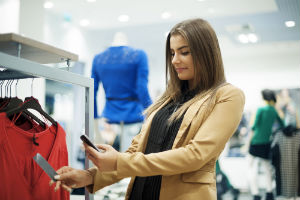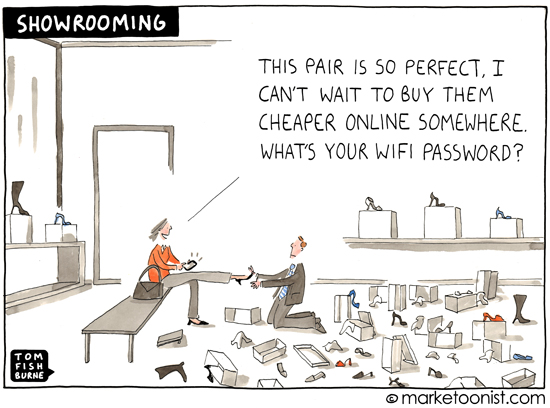 On the one hand, the speaker lineup and list of brands participating at the Pivot conference in New York this week was one of the most impressive I’ve seen for a niche event.
On the one hand, the speaker lineup and list of brands participating at the Pivot conference in New York this week was one of the most impressive I’ve seen for a niche event.
From our clients LinkedIn and Dell to a cornucopia of brands including Walmart, MTV, Intel, Kraft, Monster, NBC, General Electric, Yahoo, Adobe, Salesforce, SouthWest Airlines, General Motors, IBM, Ben & Jerry’s and many more – there was plenty of brand star power in the room.
On the other hand, the format and venue made this the most difficult liveblogging experience I’ve ever had. I’ll spare you the details, but I suspect things will be changed up for next year.
Of course the networking was excellent as were many of the interviews and presentations that I was able to see and hear.
 One that I caught is the topic of this post about showrooming with research presented by @David_Rogers, Author of a great book called, The Network is Your Customer, as well as a Professor of Digital Marketing at Columbia University School of Business.
One that I caught is the topic of this post about showrooming with research presented by @David_Rogers, Author of a great book called, The Network is Your Customer, as well as a Professor of Digital Marketing at Columbia University School of Business.
His presentation, “Integrated Experiences and the Mobile Shopper: A Research Report” shared findings from a previously unreleased report that would be of interest to any brick and mortar retailer that wants to get a better understanding of the impact mobile assisted shoppers have on the in-store and online purchase experience.
Showrooming is causing a lot of anxiety amongst retailers: “Phone Wielding Shoppers Strike Fear Into Retailers” Wall Street Journal
There’s more than a little concern from retailers as consumers use apps during the in-store shopping experience. The concern is that shoppers are checking out products in the store and then buying cheaper online or at a competitor. While some of that might be true, the devil is in the details, as they say and this report offers insights on how retailers can leverage in-store consumer mobile behaviors to their advantage.
23 Statistics and Insights from – Integrated Experiences and the Mobile Shopper: A Research Report
How many mobile assisted shoppers are there?
- 21% of all consumers
- 23% in the US
Who are Mobile Assisted Shoppers?
- 52% men
- 48% women – diverse demographic profile
- 26% Millenials
What are shoppers doing in the aisles with their mobile phones?
- 52% Price checking
- 50% Researching information and reviews
- 38% Call or text a friend or family member
A key lesson here is that consumers are not just looking at competitor sites. According to this study, they are just as likely to look at the website of the store they’re in. In fact, 12% of Walmart.com sales are from customers that are IN a Walmart store.
Are all Mobile Assisted Shoppers showrooming?
- 30% Never
- 25% Yes
- 45% On the fence. May opt to buy in store despite cheaper online
Why do some customers showroom vs. not showroom?
- Showrooming shoppers do so to get lower prices, free shipping, membership rewards or discounts,
- Shoppers that don’t showroom choose not to because they need the product right away, they don’t want to wait for shipping, it’s more convenient to shop in the store, they want on-site customer service
5 Types of Mobile Assisted Shoppers
- Exploiters – 6.1% Always showroom
- Savvys – 12.5% Very digital savvy, calculating but persuadable
- Price sensitives – 19.4% Do not plan on show rooming can be persuaded
- Experience seekers – 31.7% value the best experience, not just the price. Influenced by service, special events, store environment
- Traditionalists – 30.2% Prefer the in-store shopping experience “What’s show rooming”?
5 Strategies for Retailers
1. Offer a variety of discounts. Example: Target is testing automatic price matching
2. Convenience – Omni-channel: Retail and e-tail work together seamlessly. If you go to Walmart site while you are in the store, they will geo detect this and give you special offers. Convenience makes inshore purchases more likely.
3. Help the shopper find the right information. Think of this in terms of the mobile experience with helpful online reviews, advice on in-store products from people the shopper knows (friends/family the text or call for an opinion), provide additional product information.
4. Social engagement – Engage with customers on social platforms. Example: Evans has in-store events to encourage user reviews or products and to connect to the company’s presence on social networks.
- 33% of shoppers are open to location check in
- 31% engage with stores social media presence
5. Offer loyalty programs. Example: Best Buy – Focusing on this with “My Best Buy” rewards program that has a dedicated mobile app and website. If you do a mobile check in to a Best Buy store, they’ll give you extra rewards which can be redeemed for in-store discounts.
- 48% of shoppers decided to buy in-store vs online because they had a loyalty relationship
- 58% bought in-store to join a retailers loyalty program
If you’re a brick and mortar retailer, does showrooming concern you or affect your in-store sales? Have you observed the behaviors cited in the study above? Better yet, have you found ways for mobile to work with you for inspired in-store sales?

Cartoon by Tom Fishburne
Top Photo: Shutterstock


